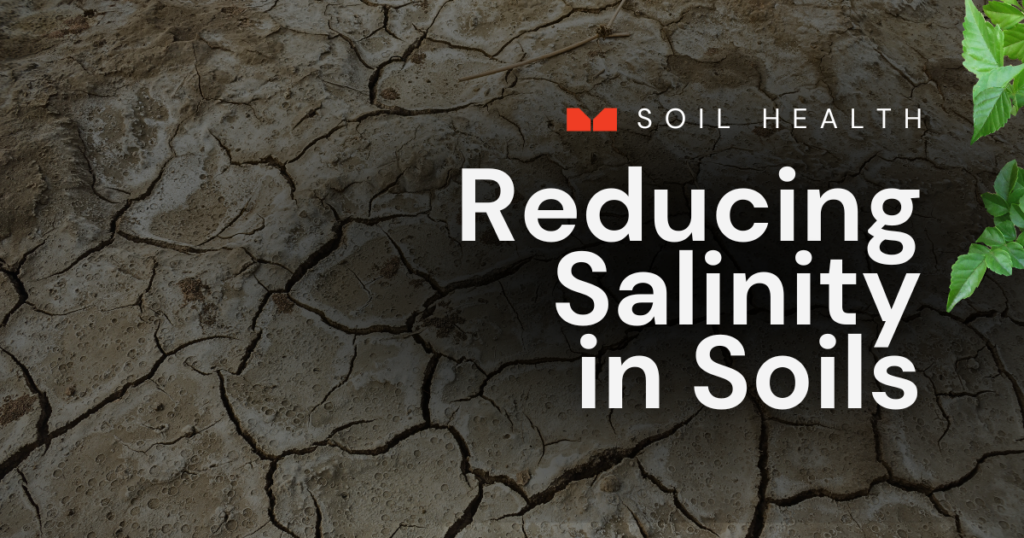
Reducing Salinity in Soil: A Path to More Sustainable Farming
Soil salinity is a major concern for growers because when salinity levels are too high, crop yields, water usage, and input costs can all be negatively impacted.
What is soil salinity?
Soil salinity is the accumulation of soluble salts in soil, and managing it can offer myriad benefits, from improved water use efficiency to reduced input needs — all of which contribute to restoring soil health1.
In this post, we explore the effects of soil salinization and the potential return on investment when salinity is in balance.
The impact of soil salinity on crops
High soil salinity is a major buzzkill for growers. Too much salt in soils can have a number of negative impacts 2. These include:
- Osmotic stress: Limiting a plant’s ability to absorb water. This process can stunt growth and reduce yields.
- Ion toxicity: A process that can disrupt plant growth, damage the cells of a plant, and decrease a plant’s resilience. This makes it challenging for farmers to achieve desired productivity.
- Damage soil structure: Salinity causes particles to disperse, often leading to poor water infiltration and issues around root growth.
Benefits of managed salinity for crops
Growers know that managing salinity spells less stressed plants. Plus, when plants are able to take up water and nutrients, they get more of what they need for a successful harvest. Happy plants not only increase productivity but also minimize the need for excess water and fertilizer inputs.
Economic and environmental savings
Decreasing soil salinity can yield substantial cost savings. High soil salinity often results in high water use, which can be not only pricey but also a strain on the environment. Reducing salinity in soil allows farmers to conserve water, which is a major win for everyone.
Lower levels of salinity also help rebalance nutrient levels in the soil. Some growers find that when salinity is in check, they can reduce fertilizers and other costly inputs, which leads to savings on production costs.
The environment also benefits from proper salinity levels. When salts are controlled, the risk of runoff and salinization of nearby water bodies is minimized, helping preserve local biodiversity and ecosystem health. Over time, restoring soil health through effective salinity management prevents land degradation and maintains agricultural productivity.
Expanded crop options and ROI
Reducing salinity can increase the range of crops that farms can accommodate, allowing them to diversify production. High salinity often restricts farms to a limited number of salt-tolerant crops, but by lowering salt levels, growers can expand into more lucrative, high-demand crops that thrive in less saline conditions.
This flexibility allows for more diverse agricultural practices that increase crop yields and potentially open new markets.
In addition to diversification, managing salinity can dramatically decrease production costs. When less water and fewer inputs are needed, farmers can reinvest those savings into other areas of their operations.
Algae’s role in salinity reduction and soil health solutions
Live, native algae contribute to soil salinity management through multiple mechanisms:
- Binding sodium with exopolysaccharides (EPS): Algae produce EPS, natural compounds that bind sodium ions, reducing sodium availability and the soil’s electrical conductivity 3.
By lowering conductivity, algae decrease the salinity stress on plants and promote better water and nutrient uptake.
- Improving soil structure: The EPS produced by algae bind soil particles, which improves aggregation and overall soil structure. Better soil structure enhances water infiltration, aeration, and root penetration, allowing for a healthier root environment that supports more vigorous crop growth 4.
This structural improvement also addresses biological indicators of soil health, as a well-aggregated soil supports microbial life essential for nutrient cycling.
- Adding organic matter: When algae goes through its life cycle and eventually decomposes, it contributes organic matter. This enhances the soil’s ability to retain water and nutrients. Increasing organic matter not only promotes the biological characteristics of soil but also fosters a robust microbial community crucial for soil function and fertility.
Over time, this organic matter plays a key role in restoring soil health, supporting both nutrient availability and microbial activity.
- Reducing soil pH and electrical conductivity: Algae release organic acids that reduce both soil pH and electrical conductivity, making the soil environment less stressful for plants. This pH balance increases nutrient availability, contributing to soil health solutions that support long-term crop productivity.
Ready to start restoring your soil?
Salinity management is essential for sustainable agriculture. By reducing soil salinity, farmers can protect the productivity of their land, reduce costs, and open to new crop possibilities.
With MyLand, farmers can embrace innovative, science-based solutions to improve their soil health and build a more sustainable future.
For further information on soil health and sustainable practices, consider resources from scientific journals such as MDPI.
References:
- Rengasamy, P. (2010). Soil processes affecting crop production in salt-affected soils. Functional Plant Biology, 37(7), 613-620. DOI: 10.1071/FP09249
- Munns, R., & Tester, M. (2008). Mechanisms of salinity tolerance. Annual Review of Plant Biology, 59, 651-681. DOI: 10.1146/annurev.arplant.59.032607.092911
- Flemming, H.-C., & Wingender, J. (2010). The biofilm matrix. Nature Reviews Microbiology, 8(9), 623-633. DOI: 10.1038/nrmicro2415
- Redmile-Gordon, M. A., Brookes, P. C., Evershed, R. P., Goulding, K. W. T., & Hirsch, P. R. (2014). Measuring the soil-microbial interface: Extraction of extracellular polymeric substances (EPS) from soil biofilms. Soil Biology and Biochemistry, 72, 163–171. DOI: 10.1016/j.soilbio.2014.01.025